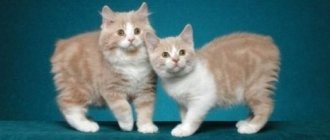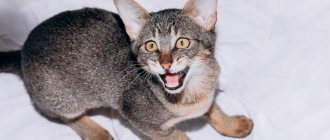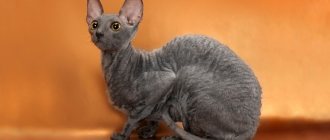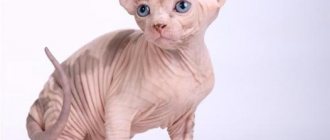The California Radiant is an incredibly rare cat breed. She was bred specifically to show people that wild animals are not a subject of hunting fun, not a toy or a trophy. It is part of nature and it is important to treat it with love and respect.
The shining Californian cat looks remarkably like a small leopard. If you want to have such an exotic animal at home, but are sure that you cannot cope with its wild nature, this is the ideal option for you. There is nothing “savage” about her. She is sweet, polite and completely safe.
Origin story
The creation of this breed had a specific purpose: to attract humanity’s attention to the problem of the unsystematic destruction of wild animals for the sake of their fur and skins. The idea was first expressed by the famous American screenwriter and writer Paul Casey. He believed that if people were given the opportunity to grow their own small copy of a wild predator at home, this would encourage them to think and abandon senseless killings. Casey was joined by anthropologist Louis Leakey.
The work began in the 70s and lasted 15 years. Many breeds were involved in the crossing: Blue Angora, Siamese, Abyssinian, British Shorthair, American Shorthair, Egyptian Street.
Generation after generation was culled and finally, many years of aspirations were crowned with success: in 1986, the new breed was officially recognized.
The homeland of the California radiant, as you might have guessed from the name, is California. But why shining? It's simple. The ancestors of the breed gifted their descendants very generously: an amazingly beautiful fur coat, smooth, bright and shiny. And what gives it shine is... golden grains of sand! There is a beautiful legend according to which some cats traveled with their owners, gold miners, and grains of the precious metal settled on their fur and remained there.
Health
Representatives of this breed have good health, good immunity, and physical endurance.
The only thing these animals are susceptible to is parasitic diseases.
Owners can recognize an infection thanks to the following key symptoms:
- Lethargy, apathy.
- Lack of appetite, refusal to eat.
- Depressed mood.
- Anemia.
- Increased fatigue.
- Abnormal bowel movements (diarrhea alternating with constipation).
With such a clinical picture, you need to show your pet to a veterinarian as soon as possible and begin treatment. Infection can be prevented by timely deworming.
On average, the life expectancy of representatives of this breed is about 15-17 years.
Standards
Representatives of the Californian shining cat are large, strong and extremely graceful animals. At first glance, it becomes clear that this is a predator, dexterous, skillful and dangerous. Weighs from 4 to 8 kg.
| Standard | Description |
| Torso | Fit, muscular, with long and slender limbs. At the same time, the hind ones are slightly longer than the front ones. Another important nuance: the radius and humerus bones converge at right angles, which affects the gait: the “Californian” does not just stomp, but seems to sneak, creep, along the ground. The paws are large, slightly flattened. The neck is medium size, strong. |
| Scull | Small, with prominent cheekbones and forehead. The chin and jaws are well developed, the muzzle is small and neat. The whisker pads are well developed and plump. |
| Eyes | Almond-shaped, large in size, set noticeably obliquely. Acceptable iris colors: gray and blue (the color must be in harmony with the coat color). |
| Ears | Small, set high, their tips rounded. |
| Tail | Long, dense. |
| Wool | In the area of the tail and belly it is longer than in other parts of the body. To the touch - soft, silky, fits tightly. |
Appearance defects:
- Green eye color;
- Pointed tail;
- Light spots on the tail.
Toyger
Their name comes from their appearance, which resembles a miniature tiger. Finding a breeder can be the hardest part of finding a Toyger and, when you find one, they can cost anywhere from $300 to $2000. This type is also known for their wonderful temperament as being very affectionate, intelligent and friendly with children and strangers. Although this type resembles a tiger, they have different personalities.
Toyger
Colors
Kittens of the Californian Radiant breed are always born dark. Why this happens has not yet been established exactly. The belly, paws and muzzle may be a little lighter, but the overall picture is the same - black. As the kitten grows older, it visually changes: a pattern begins to appear on its body and limbs. The design can be triangular, round, oval or square, in the form of crystals. But sickle-shaped, in the form of scales and rings are not allowed.
Acceptable colors:
- Gold.
- Silver.
- Bronze.
- Ginger.
- Brown.
- Jet black.
The spots should be clearly defined, with well-drawn edges and create a contrast with the main color of the coat.
In the photo there is a California shining cat of popular colors: silver, golden
Sometimes kittens are born milky white, and dark spots appear on the body as they grow older.
Characteristic
To many, a shining cat seems wild at first glance. This conclusion suggests itself based on the flexible, graceful physique, muscularity, slanted eyes and leopard-print fur coat. But experts characterize the breed with a set of the following qualities:
- strong nervous system;
- lively curiosity;
- aristocratic intelligence;
- accommodating good-natured disposition;
- wild appearance.
The breed is characterized by short hair, specific spotting and facial makeup. All lines are smooth and clear. The fur is very smooth and soft. But small kittens are always black. Only after a couple of months does the stripes and specks characteristic of Californian mini-leopards appear on it.
Character and behavior
This artificially bred breed can be called successful not only because it is strikingly beautiful in appearance. The character of these furry wonders is surprisingly friendly and affectionate. “Californians” quickly become attached to their owner and need constant attention from him. At the same time, they cannot tolerate loneliness: in an empty house they can meow pitifully for hours, wandering from room to room, refuse food, and show no interest in toys.
Just as the sun has spots (remember the famous saying?), so the shining California cats have their dark sides. Firstly, they categorically do not tolerate rude treatment. If you grab a cat by the tail, kick it, or simply raise your voice at him, he will be very offended by you.
At the same time, he will not stoop to revenge, no, but will simply begin to hide from you, refuse to play with you and will show with all his appearance how evil and bad you are. And you will have to make a lot of efforts to regain his location and good attitude.
But at the same time, “Californians” clearly distinguish between adults and children. They give the kids huge concessions, forgiving them even if they get trampled on by their paws or get hit on the back with a pillow. They do not allow themselves to hiss, release their claws or use their strong jaws: when they can no longer endure it, they run away from the battlefield and climb somewhere higher to rest.
Who can't a cat get along with?
With a parrotWith a dog
Secondly, representatives of this breed absolutely do not get along with other pets. Exceptions are so rare that they are not worth mentioning. Small animals - hamsters, dwarfs, rats, birds - evoke only one desire in the “Californians” - to grab and tear them to pieces. They try to suppress other cats and generally drive them out of the house. And don’t be afraid to get into a fight with dogs (even if the dog is much larger and looks intimidating).
The energy of “Californians” literally flows over the edge, so you will rarely see your cat peacefully sitting on the windowsill and contemplating the running of clouds across the sky. Running and playing are his favorite pastimes. He doesn’t need partners: no, of course, he will willingly accept a person into his company, but he will also be able to entertain himself very well.
From the above, the following follows: the Californian shining cat needs more space. In a small apartment, filled with furniture and appliances, littered with things, it will be very difficult for a cat to live.
Therefore, only happy owners of an apartment with a large area or their own house with a plot can get this breed.
“Californians” are smart and quick-witted, they easily and willingly learn new things, including commands. Therefore, do not miss the opportunity to teach your pet to jump on your shoulder or go to the bowl when you call. It is best to start training from childhood: kittens are more pliable. A leash for a cat is a restrictor of movement, and few adult animals easily get used to it. Therefore, a kitten should be taught to walk on a leash from an early age.
It is impossible to buy a kitten of the Californian radiant breed in Russia, Ukraine, Belarus and even in European countries. Kennels are only located in the United States of America and the animal must be reserved. The price per individual amounts to thousands of dollars!
How much does a California Shiny cat cost?
You can only buy a pure breed kitten in the USA.
The shining cat is a very expensive breed. On average, a premium kitten can cost about $2,000, i.e. more than 150 thousand rubles. Seals are priced much cheaper than cats, about 1200-1500 dollars (from 90 to 115 thousand rubles). Once a cattery has been selected, you must reserve a kitten in advance. Booking in the USA also requires a fee. Each breeder determines the cost of such a service himself. You need to be very careful when choosing a nursery. Even in America there are very few breeders breeding this breed.
Care instructions
Wool
To keep the shiny coat in its original form, you should groom it regularly. “The Californian,” in principle, is a neat guy himself, but your help is still needed from time to time. There is no need to brush your cat often; it is enough to do it a couple of times a week. Use a soft brush with natural bristles and a rubber glove (to remove any loose hairs). During the molting period - 2-3 times a week.
Bathing
California shining cats are wary of water, so don’t try to put your pet in the bathtub at every opportunity. If he gets very dirty during a walk and gets into oil or fuel oil, then yes, you can’t do without a shower. In all other cases, preventive washings once every six months are sufficient.
Ears and teeth
Ear wax is removed with a cotton pad soaked in chlorhexidine or warm boiled water. Teeth are brushed 2 times a month using a special toothbrush and cat paste.
Care products
Human cosmetics and skin and hair care products are most often poisonous to cats. If you don't wash the shampoo out of your cat's hair well and he licks himself, he'll get an upset stomach. The same applies to toothpastes.
Therefore, buy only special care products: shampoo - “Pchelodar”, “Deep Cleaning”, “Iv San Bernard”, “Bars”, Api-san; toothpaste – “Beaphar”, Clini. You can buy either a special brush (it fits on your finger) or a regular children's brush of medium softness (it will only need to trim the bristles a little).
If the animal is very stressed during the procedures, or behaves aggressively: use alternative options. Instead of bathing, your cat can be wiped with wet wipes (without fragrances or alcohol) from time to time, and taken to a veterinary clinic for teeth cleaning.
On sale there are several types of chewing pads, sticks and tidbits with the tastes of meat and fish that are pleasant to the cat. They also do a good job of removing plaque on teeth.
Peter Lysaya
Peter Bald may actually be ugly at first glance. They are thin and muscular with a narrow head and large ears. This species is the result of crossing the Oriental Shorthair and Hairless, which is why they can sometimes be hairless. This cat plays with children and other pets and is quite vocal. They are also very loyal to their owners, intelligent and energetic, so playing with them is a must. This variety typically costs between $800 and $4,000.
Peter Lysaya
Catering
From how you feed the animal. Its appearance, well-being, and lifespan depend. An unbalanced menu with the use of stale products causes irreparable harm to health.
Your cat should receive the following on a regular basis:
- Taurine (an acid that improves the functioning of the nervous and cardiovascular systems);
- Arginine (amino acid);
- Arachidonic acid;
- Fatty acid.
And, of course, proteins, carbohydrates, vitamins and mineral components. And if you feed your cat only meat or only fish, it will not be beneficial.
In the photo there are Californian radiant kittens
Natural products
The menu should include:
- Meat (veal, beef, rabbit, lamb, turkey): fresh, previously frozen. Before serving, it is doused with boiling water and cut into convenient pieces (but not until minced). Babies are supplemented with baby food from jars.
- By-products (liver, heart, lungs): 1-2 times a week.
- Fish: only sea varieties and no more than once a week (excess fish leads to kidney problems).
- Porridges made from rice, oatmeal, millet, semolina, pearl barley and buckwheat. Along with the porridge, boiled or stewed vegetables are given: zucchini, pumpkin, carrots, beets, green beans, cauliflower, broccoli, green salad, herbs.
- Vegetable (olive, flaxseed, corn) oil: half a teaspoon in porridge.
- Dairy products: low-fat cottage cheese, natural yogurt without dyes and flavors, Varenets, yogurt, unsalted hard cheese, bifido products. Whole cow's milk causes indigestion in many cats, but if your pet has been accustomed to it since childhood, you can pamper it a couple of times a week.
- Boiled egg yolk, boiled quail eggs.
- Sprouted oat or wheat sprouts.
Milk and meat should not be given together!
For a cat weighing no more than 5 kg, 150-300 grams of natural food, 60 grams of dry food or 300 grams of wet food is enough. Train your kitten to eat at the same time every day.
You should not feed your cat the following foods:
- Sausages, smoked meats, human canned food;
- Sweet, salty, peppery, hot, sour, fried, flour, baked goods;
- Citrus fruits, eggplants, avocados, grapes, potatoes, garlic, onions, tomatoes, white cabbage;
- Spices, seasonings, marinades;
- Raw meat from the market (it should be boiled thoroughly to destroy harmful impurities), duck, goose, pork;
- River fish;
- Lard, tripe, bones;
- Chocolate;
- Tea, cocoa, coffee, juices, mineral water, soda, alcohol.
Recommended food
From ready-made foods, choose holistic and super-premium foods. They are recommended by both veterinarians and experienced breeders. For the production of such food, high-quality products are used (both meat and vegetables), natural preservatives, and a useful vitamin and mineral supplement is always present.
Holistics: Canagan, Jaguar, Savarra.
Super-premium: 1st Choice, Leonardo, Natyka.
Below are recommended super-premium foods. Links with the names of the food are clickable, on them you can, within our website, get acquainted with the descriptions of the food and read reviews from owners of California Radiant cats.
| Holistic | Super premium | Super premium |
| PureLuxe | Brit Care | Sanabelle |
Premium and economy feeds are low quality feeds, widely advertised, but - alas! – useless and even harmful.
British Shorthair
This species is known for its calm nature. They get along well with all members of the household, but do not particularly like to be carried and played. This can be a problem with children. They become adults at around three years of age and come in a different range of colors and patterns. Due to their popularity and good location, this breed can cost between $100 and $500.
British Shorthair
Diseases
California shining cats boast excellent health. What’s even surprising is that it’s worth remembering how weak artificially bred breeds are and how many ailments plague them.
However, you still need to monitor his well-being!
Has your pet become unusually lethargic and sleeps a lot? Does he have prolonged diarrhea or constipation? Are there traces of blood in the stool? Does your cat vomit 2 or more times a day? Does he refuse food and water and hide in a dark corner? Does your mouth smell bad? Take your animal to the vet immediately!
Worms appear frequently in cats. First of all, this applies to animals walking outside the home. However, sources of infection can be water, meat, fleas, or your own shoes. Infection of kittens in the womb is also a common occurrence. When infected with worms, a cat begins to lose weight and become frail, its fur becomes dull, and its appetite disappears. Without treatment, worms can kill your pet. The doctor will prescribe the medications, but in the future you will need to regularly carry out deworming several times a year.
Vaccinations are another preventive measure that is dangerous to neglect. Rabies, calcivirus, chlamydia, rhinotracheitis and other viral and bacterial diseases can be avoided by vaccinating your pet on a schedule.
Expert opinion
Dusheba Vera Ivanovna
In 2010, she graduated from the Moscow State Academy of Veterinary Medicine named after K.I. Scriabin with honors, specializing in veterinary medicine. I regularly attend veterinary conferences, congresses, and webinars.
Kittens are born with “passive immunity”: it is given to the babies by the mother’s antibodies, entering the body along with colostrum. However, the protection period is short - 9-12 weeks. After which children should be vaccinated. The first vaccination is against panleukopenia and viral respiratory infections. At 12 weeks they give an injection against rabies, 2-4 weeks after - a second booster vaccination against viral respiratory infections. Vaccinations are repeated every year.
Additional vaccinations - against ringworm, chlamydia, infectious peritonitis - are also given at the request of the animal owner. Proven preparations: Nobivac Triket, Nobivac Forcat, Quadricat, Multifel-4, Fel-o-vax, Nobivac Rabies, Microderm.
Scottish lop-eared
This variety comes from the name of its Scottish origin. A special feature is the shape of his ears, which are folded back. This breed is popular due to its adaptability with children or other pets in the household. They are known for their soft voices and their habit of sleeping on their backs. In addition, many owners admit that they are loved for their desire to sit in the Buddha position, for their beautiful paws. This type typically costs between $200 and $2,500.
Scottish lop-eared
Bengal
This type of cat is known because of their affection for large families, easy maintenance, playfulness and hygiene. They usually live between 10 and 16 years and are very intelligent. The Bengal is quite noisy and is always attentive to their surroundings. They are also one of the few breeds that enjoy bathing. One of the most distinctive features of the Bengal is their spotted belly and wild appearance. A Bengal can cost $800 to $10,000 depending on whether you are buying the cat for show or not.
Bengal
Color
The coloring of this breed is one of its main advantages. There are two varieties of colors: snow leopard and royal shining. Snowy is distinguished by its completely white coat, covered with contrasting black spots, and its eyes are light blue. Kittens are born completely white at first and later develop spots.
Royal shining cat kittens are born black and only as they grow older the color changes - first, a pattern begins to appear in the upper part of the body. The pattern can be crystals, rounds, oval, rectangular and triangular. Designs such as rings, scales and sickle-shaped designs are not acceptable. The spots are evenly scattered over the body, grouped into rosettes; the body must be spotted, and the head, chest and legs are allowed to be striped.
There are no nurseries in Ukraine and Russia that breed these cats. If you wish, you must buy this animal in California.
- Price in Russia – from 105,000 rubles including reservation;
- Price in Ukraine – from 45,000 hryvnia.
It is recommended to buy a kitten from a professional nursery, which will provide the following package of documents:
- Pedigree and metrics.
- Veterinary passport.
- Green card.
- Contract of sale.
- The breeder is obliged to show the conditions of detention and the parents.
- He should also conduct a consultation on the care and maintenance of the kitten and talk about its characteristics.
- If you are unable to come personally to pick up the animal, the breeder will arrange its delivery for a fee.
It is important to understand that the purchase of such a rare animal must be approached responsibly, taking into account all the nuances, carefully studying and reading all the documents provided by the breeder. https://www.youtube.com/embed/duxzIn7Otsw. https://www.youtube.com/embed/duxzIn7Otsw
Asherah
The Asherah is the most expensive cat breed you can buy. As the most expensive cat breed in the world, the cost of these adorable kittens can be between $1,500 to $25,000. This type of cat is actually a member of the Savannah and Bengal domestic cat breed. There are rumors of resale, renaming them as Usher. Be careful if a breeder tries to sell you an Asher cat, as it just might be a Savannah. For this reason, it is the most expensive cat breed in the world because the breed is so “rare” or in other words, the breed does not exist.
Asherah
It must be borne in mind that the prices of cats depend on many factors and are often independent of the average price presented on this site, but this may be the most expensive substance in the world.










